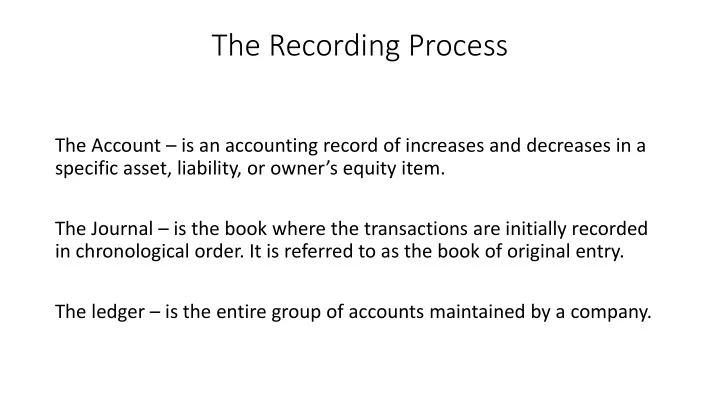

The Recording Process The Account – is an accounting record of increases and decreases in a specific asset, liability, or owner’s equity item. The Journal – is the book where the transactions are initially recorded in chronological order. It is referred to as the book of original entry. The ledger – is the entire group of accounts maintained by a company.
The Account The account consists of three parts: 1. A title 2. A left or debit side 3. A right or credit side
Assets and Liabilities Debits and Credits
Stockholders’ Equity – Common Stock Debits and Credits
Stockholders’ Equity – Retained Earnings Debits and Credits
Stockholder’s Equity - Dividends Debits and Credits
Revenue and Expenses
Debit / Credit Rule Summary
Stockholders’ Equity Relationships
Steps in the Recording Process 1. Analyze each transaction for its effects on the accounts. 2. Enter the transaction information in a journal – called journalizing. The primary journal we will use is the general journal. 3. Transfer the journal information to the appropriate accounts in the ledger – called posting.
Journalizing
Simple and Compound Entries Simple entries are those that involve only two accounts, one debit and one credit. An entry that requires more than two accounts is called a compound entry.
The Ledger The ledger is the entire group of accounts maintained by a company. A general ledger contains all the asset, liability, and stockholder’s equity accounts.
The Chart of Accounts The chart of accounts is a listing of all the individual accounts used in the operation of a business. It is structured in accounting equation order – Assets Liabilities Stockholders’ Equity Revenues Expenses
The Chart of Accounts
The Posting Process Posting is the transferring of the information in the journal entries to the General Ledger
The Posting Process
Recording Transaction 1
Recording Transaction 2
Recording Transaction 3
Recording Transaction 4
Recording Transaction 5
Recording Transaction 6
Recording Transaction 7
Recording Transaction 8
Recording Transaction 9
Recording Transaction 10
The General Journal
Posted Transactions
Trial Balance The Trial Balance is a list of all of the accounts in the general ledger and their balances at a given time.
Preparing the Trial Balance 1. List the account titles and their balances. 2. Total the debit and credit columns. 3. Prove the equality of the two columns.
A Trial Balance
Limitations The Trial Balance does not prove that all the transactions have been recorded or that the entries have been made to the proper accounts.
Recommend
More recommend